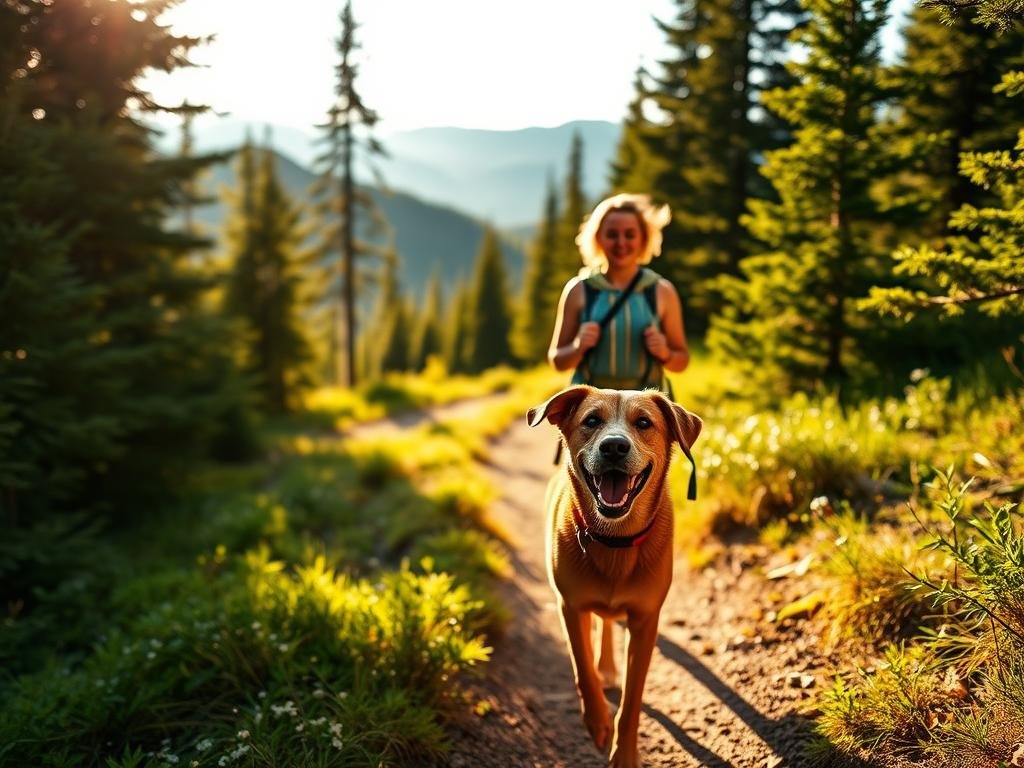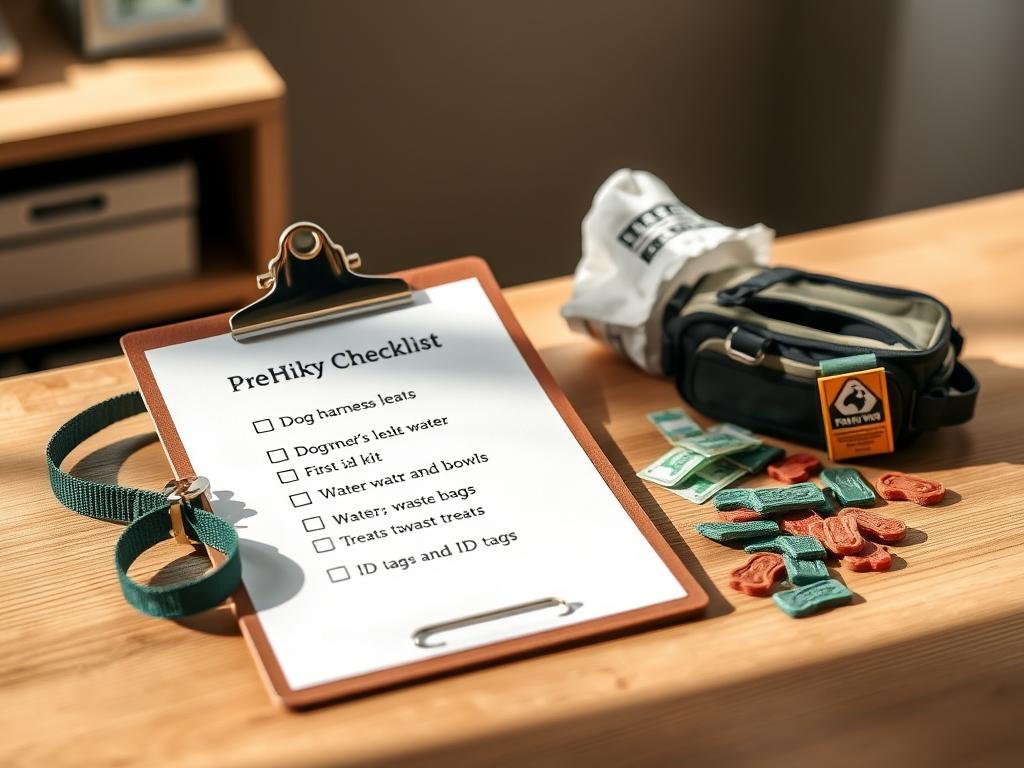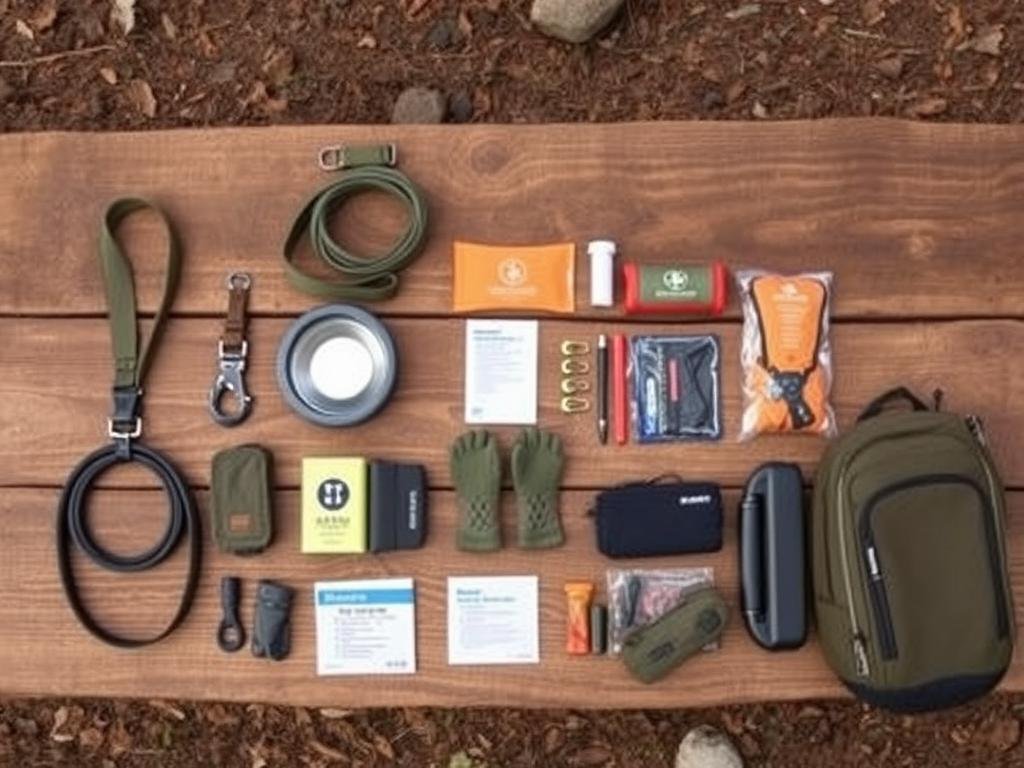More pet owners are discovering the joy of outdoor adventures alongside their four-legged friends. Since 2020, there’s been a 25% increase in dog-friendly trails across the U.S., making it easier than ever to plan a memorable trip. Whether you’re a seasoned explorer or new to the activity, understanding the essentials ensures a safe and enjoyable experience for everyone.
Preparation is key. Proper gear, like collapsible water bowls and sturdy leashes, keeps your pet hydrated and secure. Following etiquette guidelines, such as cleaning up waste and respecting wildlife, helps preserve nature for others. These small steps make a big difference.
Every adventure should prioritize your dog’s well-being. From checking trail conditions to packing essentials like durable gear, thoughtful planning ensures a smooth journey. Remember—it’s their adventure too!
Table of Contents
Key Takeaways
- Dog-friendly trails have grown by 25% since 2020.
- Hydration and leash safety are non-negotiable for pets.
- Follow Leave No Trace principles to protect the environment.
- Always check trail regulations before heading out.
- Prioritize your dog’s comfort and safety for a fun outing.
Why Hiking with Your Dog Is Good for Both of You
Exploring nature with your pup offers more than just fresh air—it builds unbreakable bonds. According to ASPCA data, trail-trained dogs show 72% stronger obedience compared to urban pets. Shared challenges, like navigating rocky paths, sharpen instincts and foster teamwork.

Physical and Mental Health Benefits
Outdoor activities provide full-body workouts. Dogs can carry up to 25% of their body weight in backpacks, promoting muscle strength. Mental stimulation comes from new scents and terrain, reducing anxiety.
- Trust-building: Stream crossings teach pups to rely on your guidance.
- Problem-solving: SAR handlers note how dogs learn to assess risks like loose rocks.
- Pheromone sync: Shared exertion releases bonding hormones.
Strengthening the Bond with Your Pup
A day outdoors deepens connections. Emergency recall drills—like calling your dog back from distractions—reinforce loyalty. Proper leash use also enhances safety and mutual trust.
These adventures aren’t just fun; they’re investments in a happier, healthier relationship.
Pre-Hike Preparations for a Safe Adventure
Planning ahead ensures both you and your furry companion enjoy the outdoors safely. Over 63% of national forests now welcome leashed pets, but rules vary widely. A little research prevents surprises and keeps tails wagging.

Assessing Your Dog’s Fitness Level
Not all pups are ready for steep climbs. Start with short walks to gauge stamina. Breeds like Border Collies thrive on challenges, while Bulldogs may need flatter trails.
Watch for these red flags:
- Heavy panting after mild activity
- Reluctance to jump or climb
- Limping or favoring one paw
Checking Trail Regulations and Weather
Federal lands have different rules than state parks. BLM areas often allow off-leash pets, while USFS trails usually require 6-foot leads. Violations can bring $300 fines in protected areas.
| Agency | Leash Rule | Dog Fees |
|---|---|---|
| National Parks (NPS) | Leashed (mostly) | $0–$25 |
| State Parks | Varies by state | $5–$15 |
| BLM Land | Often unleashed | Free |
Apps like PawCast give real-time alerts for heat risks or storms. In 2024, avoid these high-fire zones with pets:
- Southern California foothills
- Eastern Washington scrublands
- Colorado Front Range
Remember, rabies tags are mandatory in 42 states. Pack vaccine records just in case.
Essential Dog Hiking Gear Checklist
Smart gear choices can transform a simple walk into an unforgettable wilderness experience. The right tools protect paws, regulate body temperature, and handle emergencies. Here’s what every adventurer needs.

Hands-Free Leashes and Harnesses
The *Ruffwear Roamer Leash* clips to your belt, leaving arms free for balance. Pair it with the *Web Master Harness* for emergency lifts over obstacles. Reflective stitching ensures visibility at dusk.
Collapsible Bowls and Water Storage
Lightweight bowls like the *Sea to Summit Frontier* fold into pockets. For longer treks, the *Ruffwear 1L Collapsible Bottle* delivers water with a sport cap. Hydration stops should happen every 30 minutes.
First Aid Kits and Medications
Pack gauze, tweezers, and vet-approved ointments. The *Adventure Medical Kits Trail Dog* includes Co-Flex bandages for wounds. Always carry antihistamines for allergic reactions.
Booties and Cooling Jackets
The *Ruffwear Swamp Cooler* vest lowers core temps by 5°F in heat. For paws, choose materials based on conditions:
| Material | Best For | Weather Resistance |
|---|---|---|
| Neoprene | Snow/wet terrain | High |
| Cordura | Rocks/rough trails | Moderate |
- Heat risks: Brachycephalic breeds (e.g., Pugs) overheat at 85°F+.
- Paw wax: Apply *Musher’s Secret* before winter hikes to prevent cracks.
- Asphalt burns: Test surfaces with your hand—if it’s too hot for you, it harms paws.
How to Choose the Right Dog Backpack
A well-fitted backpack turns your pup into a capable trail partner. The right design balances load capacity with comfort, ensuring your furry friend stays happy mile after mile.
Weight Distribution and Fit
Dogs should carry no more than 5–15% of their body weight to avoid strain. Measure the chest girth for a snug fit—loose straps chafe, while tight ones restrict breathing.
Key features to compare:
- Barrel vs. saddle designs: Barrel packs suit narrow breeds; saddles distribute weight evenly for broad-chested dogs.
- Undercarriage clearance: Avoid packs that rub against elbows or thighs.
- Waterproofing: Look for treatments like DWR coating to keep supplies dry.
Top-Rated Packs for Every Breed
The Kurgo Journey Air Mesh excels for brachycephalic breeds with its breathable panels. For rugged trips, the Ruffwear Palisades offers detachable bags and collapsible water bottles.
Other standout options:
| Pack | Best For | Unique Feature |
|---|---|---|
| Ruffwear Approach | Active breeds | Reflective trim |
| Kurgo Baxter | Small dogs | ADA-compliant |
Pair your choice with durable gear for a seamless adventure. Always test the pack on short walks before committing to a full-day trek.
Trail Etiquette for Hiking with Dogs
Respecting trail rules keeps adventures enjoyable for everyone—including your pup. Over 400 million pounds of pet waste accumulate annually on paths nationwide. Simple courtesies like leash discipline and proper cleanup preserve access to these spaces.
Leash Laws and Right-of-Way Rules
Most public lands require 6-foot leashes—retractable models often violate regulations. Yield to solo hikers and horses, stepping aside on narrow trails. Key right-of-way reminders:
- Bikers should alert approaching pets with a bell or verbal cue
- Always maintain control when passing children or reactive animals
- Use commands like “leave it” to prevent wildlife encounters
Managing Waste Responsibly
EPA data shows uncollected droppings introduce harmful bacteria to watersheds. Opt for biodegradable poop bags with these degradation rates:
| Material | Breakdown Time |
|---|---|
| Cornstarch | 3–6 months |
| PLA plastic | 12+ months |
For backcountry trips, dig catholes 6–8 inches deep at least 200 feet from water sources. In winter:
- Pack waste in scent-proof containers like Opsak bags until disposal
- Never toss frozen waste into latrines—it won’t decompose properly
- Check local rules; some states mandate packing out all waste
Fines range from $50 (Oregon) to $300 (California) for violations. Following leave trace principles ensures trails stay open for future adventures.
Leave No Trace Principles for Dog Owners
The Leave No Trace movement now includes specific guidelines for canine companions. Updated in 2024, these rules help protect ecosystems while ensuring access to wild spaces.
Keep pets leashed or under strict voice control to prevent wildlife disturbances. This reduces stress on nesting animals and prevents habitat damage.
Choose established campsites to minimize ground impact. Set up at least 200 feet from water sources to protect aquatic ecosystems.
Restore disturbed spots by filling catholes and scattering leaves over dug-up soil. Avoid soap-based cleaners—opt for biodegradable wipes instead.
In bear country, store kibble in airtight containers or hang it 10 feet high. Never leave food unattended.
Following these steps preserves nature for all visitors. It’s how we ensure wild areas stay open and thriving.
Navigating Trail Hazards with Your Dog
Outdoor excursions bring unique challenges for pets and owners alike. From hidden dangers like ticks to unexpected wildlife encounters, preparation ensures safety for all. Understanding these risks keeps adventures enjoyable and stress-free.
Ticks, Foxtails, and Other Dangers
Trails often harbor pests that threaten your pet’s health. Foxtails can burrow into paws or ears, while ticks carry Lyme disease. Check your dog thoroughly after every outing.
Use these preventive measures:
- Booties: Protect paws from sharp rocks and hot surfaces.
- Tick repellents: Apply vet-approved treatments before heading out.
- Emergency kit: Include tweezers for tick removal and antiseptic wipes.
Watch for heat exhaustion signs like excessive panting. Move to shade immediately and offer water if symptoms appear.
Handling Wildlife Encounters
Yellowstone reports over 100 bear encounters annually, many involving off-leash pets. Leashes prevent conflicts and protect local ecosystems.
Recognize predator cues:
| Species | Warning Signs | Response |
|---|---|---|
| Bears | Ears back, huffing | Back away slowly |
| Coyotes | Stalking posture | Make loud noises |
Practice emergency recall drills using high-value treats. For added safety, equip your dog with a GPS collar in remote areas.
Migratory patterns affect risk levels. Avoid areas with nesting birds or newborn mammals during spring.
Keeping Your Dog Hydrated and Fueled
Fueling your pup properly on the trail ensures they stay energized and happy. Active dogs burn calories faster than at home, making smart food and water choices critical.
Water Needs on the Trail
Smaller dogs (under 20 lbs) need 1.5 ounces of water per pound daily, while larger breeds require 0.5–1 ounce. Plan breaks every 30 minutes to prevent dehydration. Watch for dry noses or lethargy—early signs of trouble.
For long trips, consider a portable filter for natural water sources. Avoid stagnant ponds, which may harbor harmful bacteria.
Best Snacks for Energy Boosts
High-protein treats like dehydrated liver or commercial food bars sustain energy levels. Compare glycemic indexes to avoid sugar crashes:
| Snack | Glycemic Index | Best For |
|---|---|---|
| Sweet potato bites | Low (50) | Steady energy |
| Commercial kibble | Medium (65) | Quick fuel |
Avoid: Chocolate, grapes, and raisins—toxic to dogs. At high altitudes, offer smaller meals more frequently to combat appetite loss.
- Homemade pemmican: Mix ground meat with melted fat for a calorie-dense option.
- Portion control: Limit treats to 10% of daily calories to avoid weight gain.
Emergency Preparedness for Dog Hikers
Outdoor adventures with your four-legged companion require smart safety planning. Unexpected situations can arise, from sudden weather changes to injuries. Being prepared ensures quick responses when every second counts.
GPS Collars and Rescue Gear
Modern tracking technology helps locate lost pets quickly. GPS collars like the Fi Series 3 provide real-time location updates via smartphone apps. Pair them with reflective vests for visibility in low light.
Essential rescue items include:
- Whistle: Audible up to 1 mile for attracting attention
- Emergency blanket: Retains body heat if stranded overnight
- Glow sticks: Mark trails or signal for help after dark
Recognizing Signs of Overexertion
Dogs often push beyond their limits during exciting activities. Watch for these critical warning signs:
- Bright red gums or tongue (normal color is pink)
- Panting that doesn’t slow with rest
- Stumbling or difficulty standing
Check your pet’s capillary refill time by pressing on their gums. Healthy circulation returns color within 2 seconds. Delayed response indicates dehydration or shock.
| Symptom | Action |
|---|---|
| Temperature over 104°F | Cool with wet towels and contact a vet immediately |
| Pale gums | Check for internal bleeding or anemia |
Cooling vests reduce core temperature by 5°F in hot conditions. Always carry extra water and take breaks in shaded areas. Prevention beats emergency treatment every time.
Post-Hike Care for Your Adventure Pup
Post-hike routines are just as crucial as preparation for your furry explorer. Proper aftercare prevents injuries and keeps tails wagging for future adventures. A little time spent on recovery pays off in long-term health.
Tick Checks and Paw Inspections
After every outing, run your hands through your pup’s fur to check for ticks or burrs. Pay extra attention to ears, paws, and belly—common hiding spots. Remove debris gently with tweezers to avoid irritation.
Inspect paw pads for cuts or cracks. Apply Musher’s Secret wax to soothe rough skin. For deep wounds, use antiseptic wipes and bandages.
Cool-Down Routines
Help your dog’s body recover with passive stretches. Gently extend each leg for 10 seconds, then massage shoulder and hip muscles. Avoid overstretching—keep movements slow and controlled.
For heat relief, place cool (not icy) packs on joints for 5-minute intervals. Offer electrolyte-enhanced water to replenish minerals lost during exertion.
- Rest day activities: Short walks or puzzle toys keep minds active without strain.
- Water therapy: Shallow swimming reduces joint pressure while building endurance.
Monitor energy levels for 24 hours. If fatigue persists, consult your vet. Remember, recovery time ensures your pup is ready for the next adventure.
Stories from the Trail: Real-Life Tips
Behind every successful trail story lies practical lessons worth remembering. Veteran explorers share insights that transform potential disasters into manageable moments.
A Colorado avalanche rescue team credits survival to their German Shepherd’s training. The dog alerted them to unstable snowpack 30 minutes before the slide. Key takeaways:
- Practice emergency recall daily with high-value treats
- Equip working dogs with avalanche beacons
- Monitor weather forecasts religiously
Grand Canyon rim-to-rim veterans emphasize gradual conditioning. Start with short desert hikes to build paw toughness. Their checklist:
- Apply paw wax 3x daily during training
- Use cooling vests when temps exceed 85°F
- Pack 2x more water than estimated
The Continental Divide Trail teaches resourcefulness. One thru-hiker fashioned booties from duct tape when her dog’s paws blistered. Pro tips:
- Wrap tape sticky-side out to remove foxtails
- Use carabiners to secure gear during river crossings
- Mark waypoints every 500 yards in dense terrain
Desert explorers swear by Musher’s Secret for paw protection. Reapply every 2 hours on hot sandstone. For river safety:
- Attach a floating leash for strong currents
- Check water temperature with your hand first
- Rinse salt deposits from coats after crossings
These real-world solutions prove that preparation and adaptability make every adventure safer. What unexpected lessons has your pup taught you?
Conclusion
Trail adventures thrive when safety, preparation, and responsibility come first. Prioritize hydration, check for hazards like sharp rocks or wildlife, and always leash your pup in crowded areas.
Start with short distances, gradually increasing as stamina builds. Replace worn-out gear annually—think leashes, boots, and packs—to ensure comfort.
Respect nature by packing waste bags and leaving no trace. Join local clean-up efforts to preserve trails for others.
Ready for your next outing? Download our checklist for a smooth adventure. Happy exploring!

0 Comments